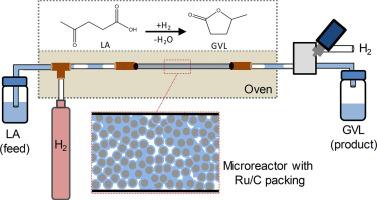Chemical Engineering Journal ( IF 13.3 ) Pub Date : 2020-06-06 , DOI: 10.1016/j.cej.2020.125750
Arne Hommes , Arie Johannes ter Horst , Meine Koeslag , Hero Jan Heeres , Jun Yue

|
The hydrogenation of levulinic acid (LA) to γ-valerolactone (GVL) was performed in perfluoroalkoxy alkane capillary microreactors packed with a carbon-supported ruthenium (Ru/C) catalyst with an average particle diameter of 0.3 or 0.45 mm. The reaction was executed under an upstream gas–liquid slug flow with 1,4-dioxane as the solvent and H2 as the hydrogen donor in the gas phase. Operating conditions (i.e., flow rate and gas to liquid flow ratio, pressure, temperature and catalyst particle size) were varied in the microreactor to determine the influence of mass transfer and kinetic characteristics on the reaction performance. At 130 °C, 12 bar H2 and a weight hourly space velocity of the liquid feed (WHSV) of 3.0 gfeed/(gcat·h), 100% LA conversion and 84% GVL yield were obtained. Under the conditions tested (70–130 °C and 9–15 bar) the reaction rate was affected by mass transfer, given the notable effect of the mixture flow rate and catalyst particle size on the LA conversion and GVL yield at a certain WHSV. A microreactor model was developed by considering gas–liquid–solid mass transfer therein and the reaction kinetics estimated from the literature correlations and data. This model well describes the measured LA conversion for varying operating conditions, provided that the internal diffusion and kinetic rates were not considered rate limiting. Liquid–solid mass transfer of hydrogen towards the external catalyst surface was thus found dominant in most experiments. The developed model can aid in the further optimization of the Ru/C catalyzed levulinic acid hydrogenation in packed bed microreactors.
中文翻译:

填充床微反应器中Ru / C催化乙酰丙酸加氢成γ-戊内酯的实验和模型研究
乙酰丙酸(LA)氢化为γ-戊内酯(GVL)在装有平均粒径为0.3或0.45 mm的碳载钌(Ru / C)催化剂的全氟烷氧基烷烃毛细管微反应器中进行。该反应在上游气液段塞流中进行,其中气相中以1,4-二恶烷为溶剂,H 2为氢供体。在微反应器中改变操作条件(即流速和气液比,压力,温度和催化剂粒度),以确定传质和动力学特性对反应性能的影响。在130°C,12 bar H 2的条件下,液体进料的重时空速(WHSV)为3.0 g进料/(gcat ·h),获得100%的LA转化率和84%的GVL收率。在一定的WHSV条件下,混合物流量和催化剂粒径对LA转化率和GVL收率有显着影响,在测试条件下(70–130°C和9–15 bar),反应速率受传质的影响。。通过考虑其中的气-液-固传质以及根据文献相关性和数据估算的反应动力学,开发了微反应器模型。该模型很好地描述了在各种工作条件下测得的LA转化率,但前提是内部扩散和动力学速率不视为速率限制。因此,在大多数实验中,氢向外部催化剂表面的液-固传质占主导地位。开发的模型可以帮助进一步优化填充床微反应器中Ru / C催化的乙酰丙酸加氢。

































 京公网安备 11010802027423号
京公网安备 11010802027423号